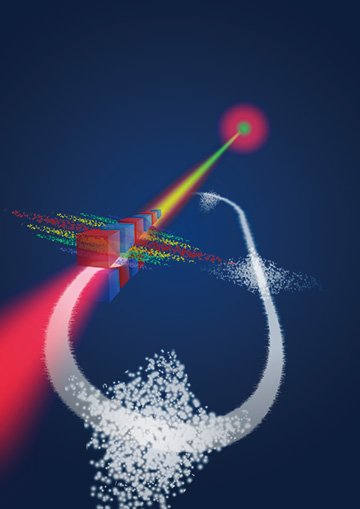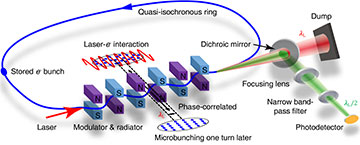
The illustration visualizes how modulation of electron bunches via laser is used to produce microbunches that emit laser light. [Image: Tsinghua University]
Scientists using particle accelerators as brilliant photon sources have had to choose between two options: a synchrotron with a storage ring, which yields high pulse-repetition rates but less power, or a linear accelerator, which offers high brightness but lousy repetition rates. A decade ago, two scientists proposed a mechanism for producing coherent radiation with the best of both acceleration models, but it remained in the theoretical realm.
Now, however, scientists based in Germany and China have experimentally demonstrated the mechanism for creating laser-like radiation pulses with high repetition rates from a synchrotron light source (Nature, doi: 10.1038/s41586-021-03203-0). The proof of concept could lead to improved photon sources, with a wide range of wavelengths, for applications ranging from fundamental physics and biology to industrial-scale lithography.
Long and short bunches
Both synchrotrons and linear accelerators produce radiation pulses by accelerating bunches of electrons to almost the speed of light. In typical synchrotrons, storage rings hold the fast-moving electron bunches without accelerating them further until the particles are released down a beamline. Linear accelerators use each bunch only once, giving a brilliant flash—but limiting the number of flashes to the rate at which the accelerator can speed up the particle clusters.
In 2010, two physicists at Stanford University, USA, theorized that shortening the length of the electron bunches in a storage ring could generate the desired combination of high power and high repetition rates. They dubbed their model “solid-state microbunching” (SSMB) because it shrinks the size of these bunches from the 1-mm-to-10-mm range down to the scale of 10 μm to a few nanometers. Xiujie Deng of Tsinghua University, China, developed the theory further, and one of the Stanford scientists, Alexander Chao, joined Deng and Tsinghua’s Chuanxiang Tang in proposing the experiment at an existing synchrotron radiation facility.
The synchrotron setup

Experimental setup. The stored electron bunches are modulated by a laser in an undulator. They become microbunched after one revolution in the storage ring and produce coherent radiation. [Image: PTB/HZB]
For the experiment, the physicists turned to the Metrology Light Source (MLS), a synchrotron storage ring operated by the Physikalisch-Technische Bundesanstalt (PTB), Germany. The team stored 250-MeV electron bunches in the quasi-isochronous storage ring and modulated them with a 1064-nm laser beam. Just past the point at which the laser beam is injected into the storage ring, a planar modulator modulates the energies of the electrons, and after one trip around the ring (48 m in circumference), the electrons have clustered themselves into microbunches about 1 μm long. A dichroic mirror and other optics focused the second harmonic of the modulated beam into a photodetector to confirm the microbunching behavior.
“The huge challenge we had to face was to maintain the phase correlation between the electron energies, introduced by the laser fields, over one complete revolution in a storage ring,” says Jörg Feikes, an accelerator specialist at the Helmholtz-Zentrum Berlin (HZB), Germany. “This precise turn-by-turn phase correction is the mechanism to support the realization of steady-state microbunching.”
The MLS, in operation since 2008, was not designed for SSMB experiments, according to Feikes. However, it had one distinction crucial to the success of this project: It is the first accelerator storage ring optimized for running in “low alpha mode,” in which the revolution time of the electrons becomes nearly independent from their energies.
“When we adjusted this isochronal property to its absolute technical limit, several physical effects appeared which are normally not seen in a storage ring,” Feikes says. “This physics had to be understood and its microbunch-destroying effects had to be mitigated by a sophisticated adjustment of the SSMB machine state.”
What’s next
After this proof of concept, the Chinese-German team will extend the duration of the experiment from one lap around the storage ring (with a duration of only 160 ns) to many turns, with the final goal to maintain the microbunching at time scales in the order of many seconds, Feikes says.
Tsinghua University has delivered to the MLS a new laser with a very high repetition rate. According to Feikes, the laser will fire its pulses on every turn at exactly the same phase of the passing electrons. “With this, we will learn important issues concerning the time evolution of a microbunch and how to preserve its microstructure of a longer time period,” he says.
“The Tsinghua University is actually planning to construct the first SSMB-dedicated synchrotron light source near Beijing with special emphasis on high-power EUV generation for industrial applications as semiconductor lithography,” Feikes adds. “With this project approved soon, it might start its operation still in this decade. Here the demands on the technical infrastructure and physical conditions are tremendous, as the microbunches would be much shorter than in our experiment and would be continuously maintained in a ‘steady state’ while simultaneously radiating at high power.”
